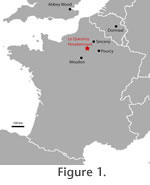|
|
|
INTRODUCTIONOxyaenidae is one of the families included in the diphyletic order "Creodonta", with the Hyaenodontidae. Oxyaenidae represent the largest specialized carnivorous mammals from the Early and Middle Eocene, whereas Mesonychidae represent the largest non-specialized carnivorous mammals. They were distinctly larger and possessed a more specialized shearing dentition than the hyaenodontids. Four subfamilies are known: Tytthaeninae, the most primitive group; Ambloctoninae (= Palaeonictinae) characterized by a reduced M2 and broad premolars; Oxyaeninae characterized by a large and bladelike M2; and the hypercarnivorous Machaeroidinae characterized by a very bladelike M2 and long upper canines protected by a ventral flange at the front of the jaw (Gunnell 1998). However, the placement of Machaeroidinae is presently uncertain, because they may belong to Oxyaenidae or to Hyaenodontidae. The group appeared in North America during the Late Paleocene (Gingerich 1980). Its diversification occurred mainly on this continent. It disappeared from North America during the Middle Eocene. Oxyaenidae appeared in Europe right after the Paleocene/Eocene transition (Smith and Smith 2001), and they disappeared rapidly there. Only oxyaenines and paleonictines are known in Europe. The Oxyaenidae are poorly known in Europe because they are rare and represented by very poor material (Rich 1971; Gunnell and Gingerich 1991).
Thanks to this locality, our knowledge of the earliest Oxyaenidae is greatly increased. Nearly complete dentitions of oxyaenids are known from Le Quesnoy, allowing a new look at the fossils of Oxyaenidae previously discovered in Europe (Van Valen 1965; Rich 1971; Hooker 1998) and to a discussion of the evolution of this group in Europe. Abbreviations
|
|
